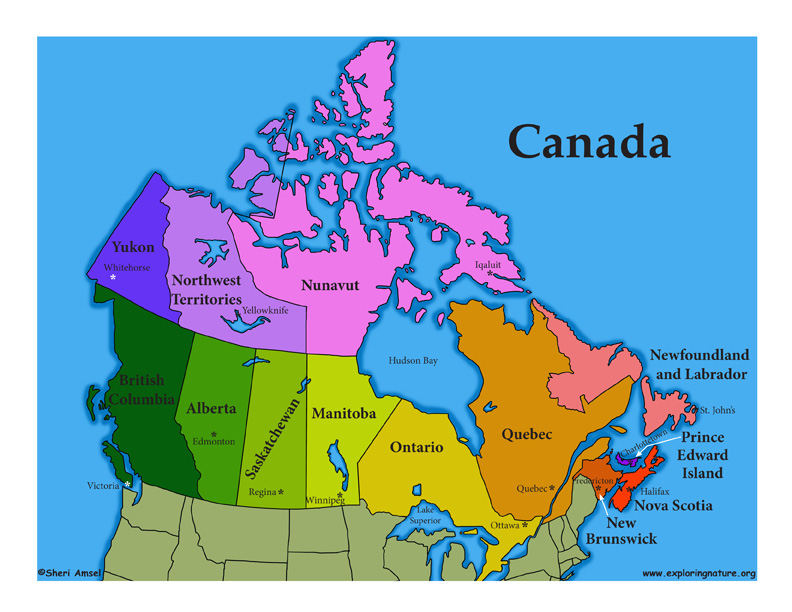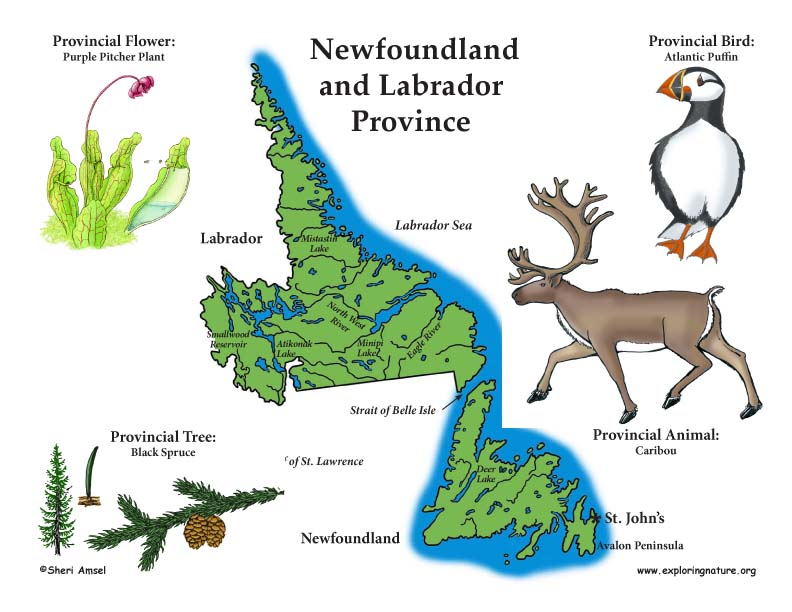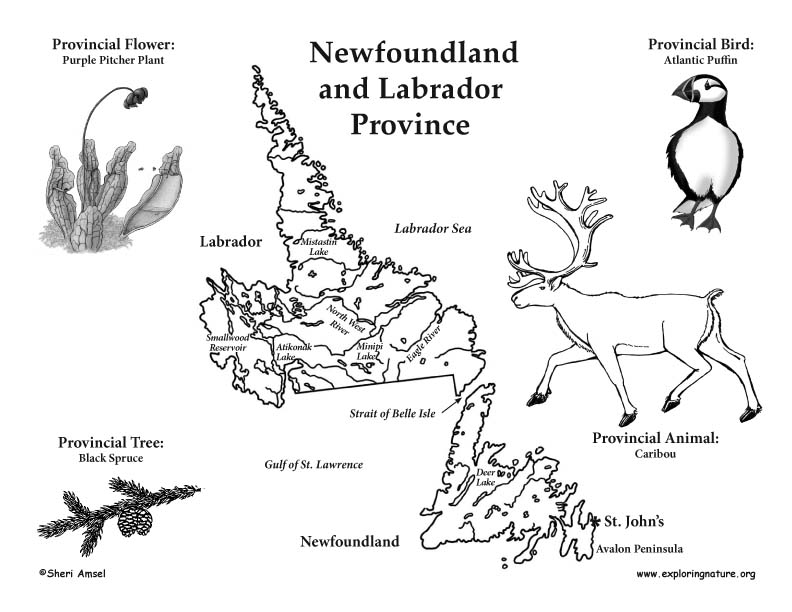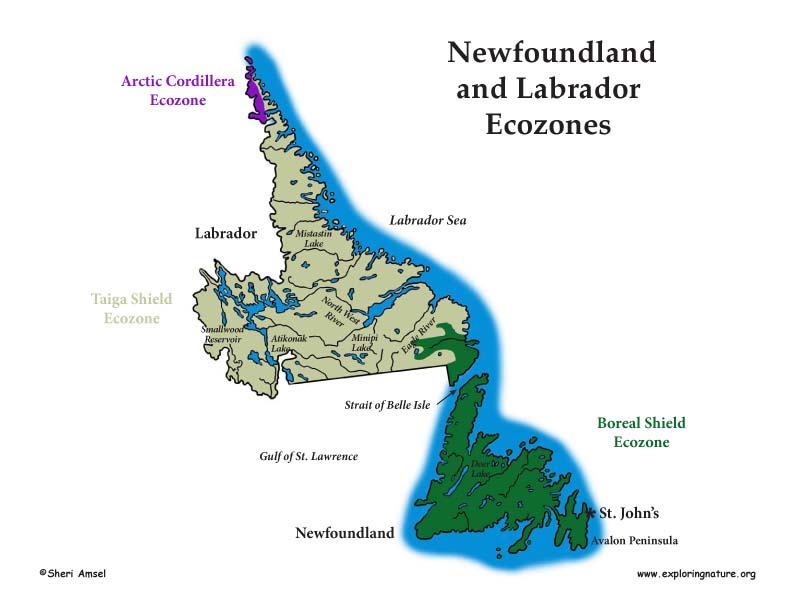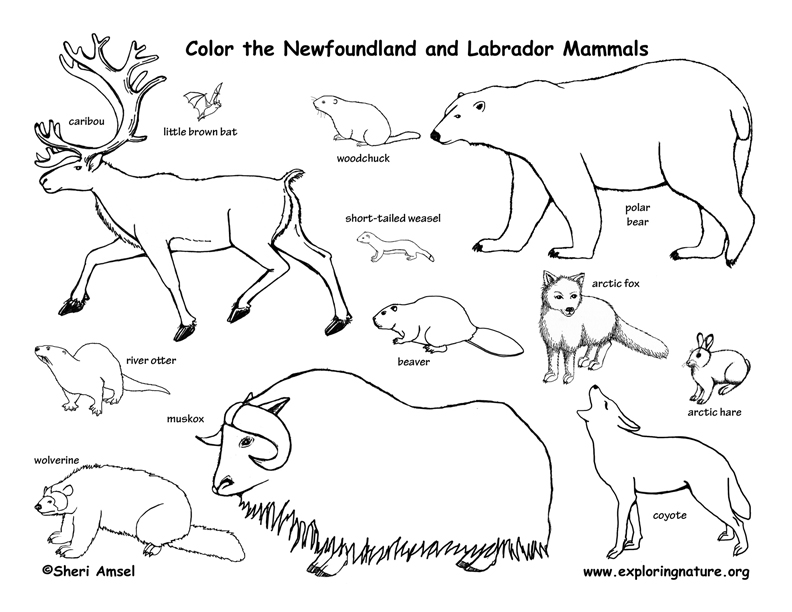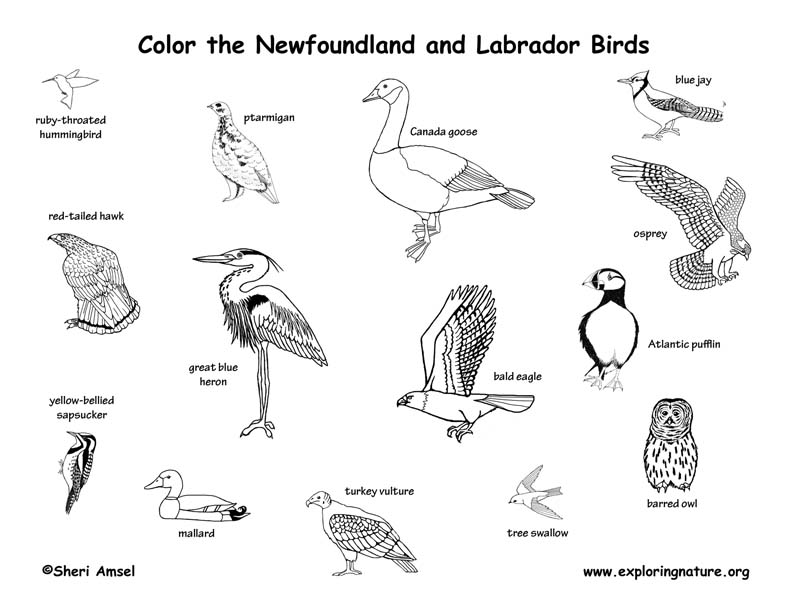

Newfoundland and Labrador is a Canadian Province located on the Atlantic coast (the most eastern Province). Labrador is on the mainland and Newfoundland is an island off the coast with the Strait of Belle Isle between them. In addition, there are more than 7,000 small islands along the coastline of the Province. All together, the Province makes up 100 million acres (405,212 square km or 156,500 square miles).
Most people (more than 90%) live on Newfoundland and most of those are on the southeastern Avalon Peninsula. The capital is St. John's, which is also the province's largest city, housing almost half the province's population (about 40%). Weather helps determine where the population lives, as Labrador is polar tundra and subarctic, while Newfoundland is more temperate.
Northern Labrador is a treeless tundra plain with very long, very cold winters. It is in this region that barren-ground caribou come to have young in the short, cool summers. Because of the permafrost, the ground is wet throughout the summer and grows only dwarf shrubs, mosses, sedges and lichens.
Further south is the taiga or boreal forest that covers 94-million acres (380,000 square km). Black spruce and balsam fir (the most common tree species). Some white birch and quaking aspen can be found mixed in with the conifers. In total, there are 21 species of trees in the Province with those sensitive to severe weather found in southern Newfoundland. These include jack pine, black ash, red pine, red and mountain maple, yellow birch, balsam poplar, mountain ash, pin and choke cherry and mountain alder. In and amongst the boreal forest are wetlands – peatlands, bogs and fens. This region is vital breeding ground to millions of birds and home to woodland caribou.
Newfoundland and Labrador have more than 3,000 boreal woodland caribou. It is the breeding ground for more than 150 species of birds. As many as 200 million birds breed there each year.
The Province of Newfoundland and Labrador has been broken down by scientists into Ecozones – Arctic Cordillera, Taiga Shield, and Boreal Shield Ecozones.
The most northern tip of Labrador has a sliver of Arctic Cordilla Ecozone. This is a region of jutting rocks, mountain chains, polar ice fields and glaciers along the coast of deep fiords. It is a beautiful region with an extreme climate. The few hardy plants and lichens are the only food source for the region's two herbivores - the musk ox and barren-ground caribou. Other mammals include polar bear, arctic wolf, arctic fox, arctic hare, weasels and lemmings.
The Eastern Taiga Shield Ecozone is a flat, wet region of subarctic shrub tundra (in the north) and boreal forest (in the south) with long, cold winters. It acts as the transition between the Arctic and boreal forests and is dotted with millions of lakes left by the retreat of the glaciers. The lakes and bogs make it a popular breeding ground for waterfowl. The forest includes: black and white spruce, jack pine, green alder, paper, white and dwarf birch, tamarack, balsam fir, quaking aspen, and balsam poplar. The region supports animals that can tolerate subarctic conditions, including black, grizzly and polar bear, wolf, lynx, moose, barren-ground and woodland caribou, coyote, weasel, wolverine, river otter, red and arctic fox, muskrat, marten, mink, beaver, vole, red squirrel, and snowshoe hare.
The Boreal Shield Ecozone is a huge ecozone that stretches all across Canada with rolling hills covered in boreal forest. Millions of lakes were left by the retreat of the glaciers. These, along with with its abundant bogs and fens found throughout the region, make it a popular breeding ground for waterfowl. The forests here include: black and white spruce, jack pine, green alder, paper, white and dwarf birch, tamarack, balsam fir, quaking aspen, and balsam poplar. The region supports black bear, wolf, lynx, moose, barren-ground and woodland caribou, coyote, weasel, wolverine, river otter, red and arctic fox, muskrat, marten, mink, beaver, voles, red squirrels, and snowshoe hare.
Mammals:
bat (eastern long-eared)
bat (hoary)
bat (little brown)
bear (black)
bear (polar)
beaver
caribou
chipmunk (eastern)
coyote
fisher
fox (arctic)
fox (red)
hare (arctic)
lemming (northern bog)
lemming (Ungava)
lynx (Canadian)
marten
mink (introduced)
mole (star-nosed)
moose
mouse (deer)
mouse (house)
mouse (meadow jumping)
mouse (woodland jumping)
muskrat
musk ox
otter (river)
porcupine
rat (Norway)
shrew (masked)
shrew (pygmy)
shrew (water)
squirrel (northern flying)
squirrel (red)
vole (bank)
vole (heather)
vole (meadow)
vole (red-backed)
weasel (short-tailed or ermine)
wolverine
woodchuck
Birds:
auk (great)
avocet (American)
bittern (American)
bittern (least)
blackbird (Brewer's)
blackbird (Eurasian)
blackbird (red-winged)
blackbird (rusty)
blackbird (yellow-headed)
bluebird (eastern)
bluebird (mountain)
bobolink
bunting (indigo)
bunting (lark)
bunting (painted)
bunting (snow)
catbird (gray)
chaffinch (common)
chat (yellow-breasted)
chickadee (black-capped)
chickadee (boreal)
Chuck-will's-widow
coot (American)
coot (common)
cormorant (double-crested)
cormorant (great)
corncrake
cowbird (brown-headed)
crane (sandhill)
creeper (brown)
crossbill (red)
crossbill (white-winged)
crow (American)
cuckoo (black-billed)
cuckoo (yellow-billed)
curlew (Eskimo) - endangered
curlew (Eurasian)
dove (mourning)
dove (rock)
dove (white-winged)
dovekie
dowitcher (long-billed)
dowitcher (short-billed)
duck (American black)
duck (American widgeon)
duck (Barrow's goldeneye)
duck (black scoter)
duck (blue-winged teal)
duck (bufflehead)
duck (canvasback)
duck (cinnamon teal)
duck (common eider)
duck (common goldeneye)
duck (Eurasian widgeon)
duck (fulvous whistling)
duck (gadwall)
duck (garganey)
duck (greater scaup)
duck (harlequin)
duck (king eider)
duck (lesser scaup)
duck (long-tailed or oldsquaw)
duck (mallard)
duck (northern pintail)
duck (northern shoveler)
duck (redhead)
duck (ring-necked)
duck (ruddy)
duck (surf scoter)
duck (tufted)
duck (white-winged scoter)
duck (wood)
dunlin
eagle (bald)
eagle (golden)
egret (cattle)
egret (great)
egret (little)
egret (snowy)
egret (western reef)
falcon (gyrfalcon)
falcon (peregrine)
fieldfare
finch (purple)
flamingo (greater)
flicker (northern)
flycatcher (alder)
flycatcher (ash-throated)
flycatcher (fork-tailed)
flycatcher (great-crested)
flycatcher (least)
flycatcher (olive-sided)
flycatcher (scissor-tailed)
flycatcher (sulfur-bellied)
flycatcher (yellow-bellied)
frigatebird (magnificent)
gallinule (purple)
gannet (northern)
godwit (bar-tailed)
godwit (black-tailed)
godwit (Hudsonian)
godwit (marbled)
goldfinch (American)
goose (barnacle)
goose (brant)
goose (Canada)
goose (great white-fronted)
goose (graylag)
goose (pink-footed)
goose (Ross's)
goose (snow)
grackle (common)
grèbe (horned)
grèbe (pied-billed)
grèbe (red-necked)
greenshank (common)
grosbeak (black-headed)
grosbeak (blue)
grosbeak (evening)
grosbeak (pine)
grosbeak (rose-breasted)
grouse (ruffed)
grouse (spruce)
grouse (willow)
guillemot (black)
gull (black-headed)
gull (black-tailed)
gull (Bonaparte’s)
gull (Franklin's)
gull (glaucous)
gull (great black-backed)
gull (herring)
gull (Iceland)
gull (ivory)
gull (laughing)
gull (lesser black-backed)
gull (little)
gull (mew)
gull (ring-billed)
gull (Ross's)
gull (Sabine's)
gull (slaty-backed)
gull (Thayer's)
gull (yellow-legged)
harrier (northern)
hawk (Cooper's)
hawk (northern goshawk)
hawk (red-tailed)
hawk (rough-legged)
hawk (sharp-shinned)
hawk (Swainson's)
heron (black-crowned night)
heron (gray)
heron (great blue)
heron (green)
heron (little blue)
heron (yellow-crowned night)
hobby (Eurasian)
hummingbird (Anna's)
hummingbird (ruby-throated)
hummingbird (rufous)
ibis (glossy)
ibis (white)
jackdaw (Eurasian)
jaeger (long-tailed)
jaeger (parasitic)
jaeger (pomarine)
jay (blue)
jay (gray)
junco (dark-eyed)
kestrel (American)
killdeer
kingbird (eastern)
kingbird (western)
kingfisher (belted)
kinglet (golden-crowned)
kinglet (ruby-crowned)
kittiwake (black-legged)
lapwing (northern)
lark (horned)
longspur (chestnut-collared)
longspur (Lapland)
loon (common)
loon (Pacific)
loon (red-throated)
magpie (black-billed)
martin (purple)
meadowlark (eastern)
merganser (common)
merganser (hooded)
merganser (red-breasted) or goosander
merlin
mockingbird (northern)
moorhen (common)
murre (common)
murre (thick-billed)
murrelet (long-billed)
nighthawk (common)
nuthatch (red-breasted)
nuthatch (white-breasted)
oriole (Baltimore)
oriole (Bullock's)
oriole (orchard)
osprey
ovenbird
owl (barn)
owl (barred)
owl (boreal)
owl (great gray)
owl (great horned)
owl (long-eared)
owl (northern hawk)
owl (northern saw-whet)
owl (short-eared)
owl (snowy)
oystercatcher (Eurasian)
parula (northern)
pelican (American white)
pelican (brown)
petrel (Cape Verde)
pewee (eastern wood)
phalarope (red)
phalarope (red-necked)
phalarope (Wilson's)
phoebe (eastern)
phoebe (Say's)
pipit (buff-bellied)
plover (American golden)
plover (black-bellied)
plover (common ringed)
plover (Eurasian)
plover (Pacific golden)
plover (piping)
plover (semipalmated)
ptarmigan (rock)
puffin (Atlantic)
rail (clapper)
rail (king)
rail (sora)
rail (Virginia)
raven (common)
razorbill
red knot
redpoll (common)
redpoll (hoary)
redshank (common)
redshank (spotted)
redstart (American)
redwing
robin (American)
ruff
sanderling
sandpiper (Baird's)
sandpiper (buff-breasted)
sandpiper (curlew)
sandpiper (least)
sandpiper (pectoral)
sandpiper (purple)
sandpiper (semipalmated)
sandpiper (solitary)
sandpiper (spotted)
sandpiper (stilt)
sandpiper (western)
sandpiper (white-rumped)
sandpiper (wood)
sapsucker (yellow-bellied)
shearwater (Cory's)
shearwater (great)
shearwater (manx)
shearwater (sooty)
shrike (northern or great grey)
siskin (pine)
skimmer (black)
skua (great)
skua (pomarine)
skua (south polar)
snipe (common)
solitaire (Townsend's)
sparrow (American tree)
sparrow (chipping)
sparrow (clay-colored)
sparrow (field)
sparrow (fox)
sparrow (grasshopper)
sparrow (Harris's)
sparrow (house)
sparrow (lark)
sparrow (Lincoln's)
sparrow (Savannah)
sparrow (swamp)
sparrow (vesper)
sparrow (white-crowned)
sparrow (white-throated)
starling
stilt (black-winged)
storm-petrel (Leach's)
storm-petrel (Wilson's)
swallow (bank)
swallow (barn)
swallow (cave)
swallow (cliff)
swallow (northern rough-winged)
swallow (tree)
swallow (violet-green)
swan (tundra)
swan (whooper)
swift (chimney)
tanager (scarlet)
tanager (summer)
tanager (western)
tern (Arctic)
tern (black
tern (bridled)
tern (Caspian)
tern (common)
tern (Forster's)
tern (gull-billed)
tern (least)
tern (roseate)
tern (royal)
tern (sandwich)
tern (sooty)
thrasher (brown)
tropicbird (white-tailed)
thrush (gray-cheeked)
thrush (hermit)
thrush (Swainson's)
thrush (varied)
thrush (wood)
towhee (eastern)
towhee (spotted)
turnstone (ruddy)
veery
vireo (blue-headed)
vireo (Philadelphia)
vireo (red-eyed)
vireo (warbling)
vireo (white-eyed)
vireo (yellow-throated)
vulture (turkey)
warbler (bay-breasted)
warbler (blackburnian)
warbler (blackpoll)
warbler (black-and-white)
warbler (black-throated blue)
warbler (black-throated gray)
warbler (black-throated green)
warbler (blue-winged)
warbler (Canada)
warbler (Cape May)
warbler (cerulean)
warbler (chestnut-sided)
warbler (Connecticut)
warbler (golden-winged)
warbler (hermit)
warbler (hooded)
warbler (Kentucky)
warbler (magnolia)
warbler (mourning)
warbler (Nashville)
warbler (orange-crowned)
warbler (palm)
warbler (pine)
warbler (prairie)
warbler (prothonotary)
warbler (Tennessee)
warbler (Townsend's)
warbler (Virginia)
warbler (Wilson's)
warbler (worm-eating)
warbler (yellow)
warbler (yellow-rumped)
warbler (yellow-throated)
wagtail (white)
waterthrush (northern)
waxwing (Bohemian)
waxwing (cedar)
wheatear (northern)
whimbrel
willet
woodcock (American)
woodcock (Eurasian)
woodpecker (American three-toed)
woodpecker (black-backed)
woodpecker (downy)
woodpecker (hairy)
woodpecker (Lewis's)
woodpecker (red-bellied)
woodpecker (red-headed)
woodpecker (yellow-bellied sapsucker)
wren (house)
wren (marsh)
wren (rock)
wren (winter)
yellowlegs (greater)
yellowlegs (lesser)
yellowthroat (common)
Amphibians (No Reptiles):
frog (mink) - Lithobates septentrionalis
frog (northern green) - Lithobates clamitans melanota
frog (northern leopard) - Lithobates pipiens
frog (wood) - Lithobates sylvaticus
salamander (blue-spotted) - Ambystoma laterale
salamander (northern two-lined) - Eurycea bislineata
toad (American) -Anaxyrus americanus americanus
treefrog (western chorus) - Pseudacris triseriata
Wild Science Workbook
Activities that Bridge Outdoor Exploration with Classroom Science
The activities in Wild Science will integrate outdoor exploration with the understanding and appreciation of science and environmental issues.
Using Wild Science as a guide, we invite you to rediscover your sense of wonder about the natural world and share it with the children you know.
When you research information you must cite the reference. Citing for websites is different from citing from books, magazines and periodicals. The style of citing shown here is from the MLA Style Citations (Modern Language Association).
When citing a WEBSITE the general format is as follows.
Author Last Name, First Name(s). "Title: Subtitle of Part of Web Page, if appropriate." Title: Subtitle: Section of Page if appropriate. Sponsoring/Publishing Agency, If Given. Additional significant descriptive information. Date of Electronic Publication or other Date, such as Last Updated. Day Month Year of access < URL >.
Amsel, Sheri. "Canadian Province - Newfoundland and Labrador" Exploring Nature Educational Resource ©2005-2024. December 14, 2024
< http://www.exploringnature.org/db/view/1763 >
